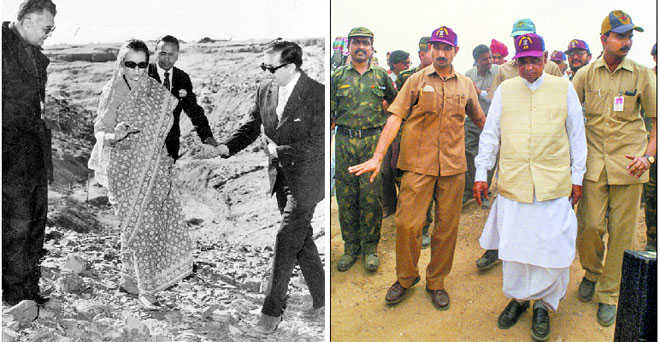
RELUCTANT N-POWER: Then PMs Indira Gandhi (left) and Atal Bihari Vajpayee (right) inspect the test site 24 years apart.
Brig Gurmeet Kanwal (retd)
Former Director, Centre for Land Warfare Studies, New Delhi
Twenty years ago, India conducted five nuclear tests over two days on May 11 and 13, 1998, and declared itself a state armed with nuclear weapons. With a pacifist strategic culture steeped in Gandhian non-violence, India is a reluctant nuclear power. India had sought but had been denied nuclear guarantees and had no option but to acquire nuclear weapons. India believes that nuclear weapons are political weapons, not weapons of war-fighting. Their sole purpose is to deter the use and threat of use of nuclear weapons.
India’s nuclear doctrine is built around the concept of ‘credible minimum deterrence’ and a ‘no first use’ (NFU) posture. As a corollary to its NFU posture, India has declared its intention of launching massive retaliation if there is a first strike on India. Consequently, India follows a policy of ‘deterrence by punishment’ through a ‘counter value’ targeting strategy aimed at inflicting unacceptable damage, as against a ‘counter force’ strategy aimed at destroying the adversary’s nuclear forces.
India’s nuclear force structure comprises a land, sea and air-based triad: Agni-I to IV IRBMs manned by the Missile Groups of the Indian Army; nuclear glide bombs under-slung on Mirage 2000 and SU-30 MKI fighter-bomber aircraft of the Indian Air Force; and, in due course, SLBMs on SSBNs with the Indian Navy. While INS Arihant, the first indigenously designed nuclear submarine, has been made fully operational, a second SSBN is reported to be under construction.
Not on the battlefield
India has willingly abjured the use of ‘tactical’ or ‘battlefield’ nuclear weapons as these are inherently destabilising. Tactical nuclear weapons are mainly employed against armed forces targets in the TBA (tactical battle area) and tend to lower the threshold of use due to the proclivity to ‘use them or lose them’. These also involve complicated command and control mechanisms, enhance the risk of unauthorised and accidental launches and are complex and costly to manufacture and maintain.
The total number of warheads that India needs for credible minimum deterrence in a NFU scenario, has not been articulated by the government. In the views of Indian analysts, the requirement varies from a few dozen warheads at the lower end of the scale to over 400 warheads at the upper end. In terms of yield these range from 10 to 12 kilotons to megaton monsters.
After the Pokhran nuclear tests of May 1998, in which warheads based on both fission and fusion designs were tested, India claimed that it had acquired the capability to manufacture nuclear warheads with yields varying from sub-kiloton to a maximum of 200 kilotons. Notably, India’s nuclear capabilities are completely indigenous despite the stringent technology denial regimes and sanctions that India has been subjected to since 1974 when a ‘peaceful nuclear explosion’ (PNE) was conducted ostensibly for civilian purposes. While some of these sanctions have been lifted, many others still remain in place.
Unlike in China, which has an authoritarian regime, and in Pakistan, where the army calls the shots on key policy issues, India’s nuclear weapons are firmly under civilian control. But India does not yet have a Chief of Defence Staff to provide single-point military advice to the government. It is imperative that the appointment of CDS be approved as early as possible.
The Commander-in-Chief, Strategic Forces Command (SFC) advises the Chiefs of Staff Committee (CoSC) on all aspects of nuclear deterrence and exercises operational and technical control over the nuclear forces. The nuclear delivery assets (ballistic missiles groups, fighter-bomber squadrons and the SSBNs) are raised, manned, equipped and maintained by respective Services HQ.
A chain of succession has been formulated. India has established a National Command Post (NCP) that will also act as a tri-service operations centre during war. Rehearsals and joint exercises involving simulated retaliatory nuclear strikes are carried out periodically.
Adequate checks
Adequate checks and balances for the safety and security of nuclear warheads, the prevention of unauthorised use and the minimisation of the possibility of accidental detonation have been built into standard operating procedures (SOPs) for the custody, storage, handling and transportation of nuclear warheads during peace time. Nuclear warheads are kept unmated and are stored separately from the launchers. The nuclear cores are in the custody of the Atomic Energy Commission (AEC) and the high explosive triggers are in the custody of the Defence Research and Development Organisation (DRDO).
Limited mating?
With the ‘cannisterisation’ of some of the ballistic missiles carried on mobile launchers, it would be prudent to assume that limited mating of warheads would have taken place, but with permissive action links (PALs – electronic locks) having been installed to arm the missiles and the warheads. The launch platforms are manned by the armed forces and are not deployed till necessary. This reduces the risk of accidental and inadvertent launch and enhances peace time safety.
India has consistently been a strong advocate of total or universal nuclear disarmament. The Nehruvian policy did not change even after the Pokhran tests of May 1998 as nuclear disarmament is seen to be in India’s interest. Despite not having signed the NPT, the CTBT and the MTCR, India has complied with all the provisions of these treaties and supports the early conclusion of discussions on the FMCT.
India views these international treaties as important enablers of non-proliferation, arms control and disarmament measures that are necessary for regional and international peace and stability. India has voluntarily renounced further nuclear testing and has an unblemished non-proliferation record among the nuclear weapons powers.
India is willing to discuss and institute nuclear CBMs and nuclear risk reduction measures (NRRMs) with both China and Pakistan, but its overtures have not been suitably reciprocated. China still does not recognise India as a nuclear power and refuses to discuss nuclear CBMs. The nuclear CBMs in place with Pakistan are cosmetic in nature and need to be upgraded to more substantive ones.


























